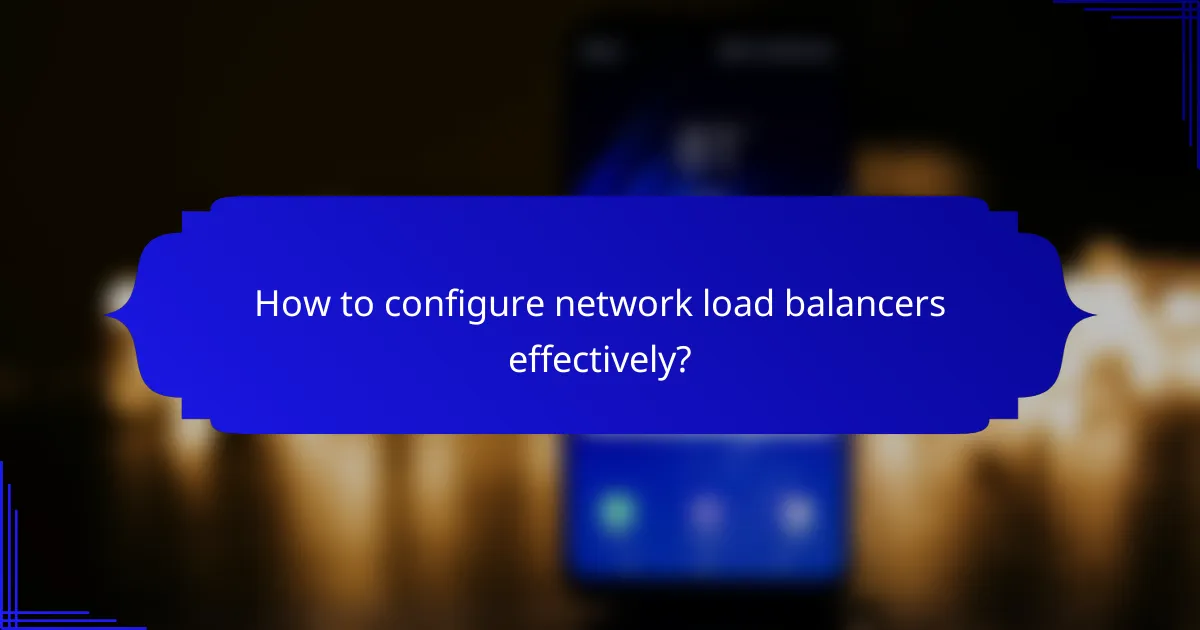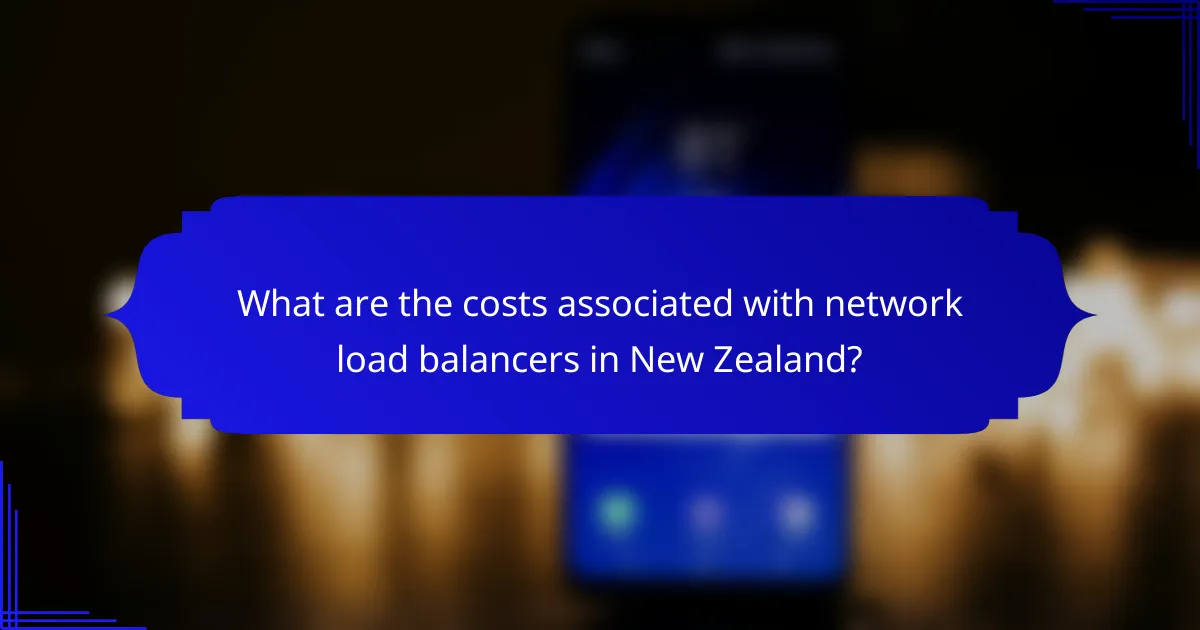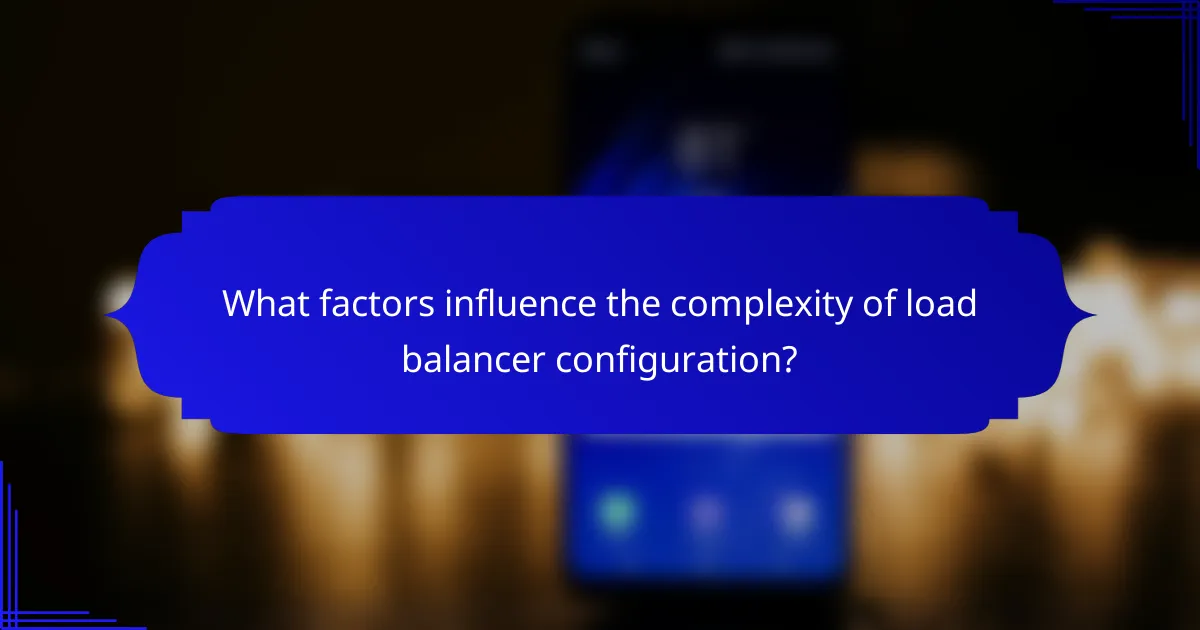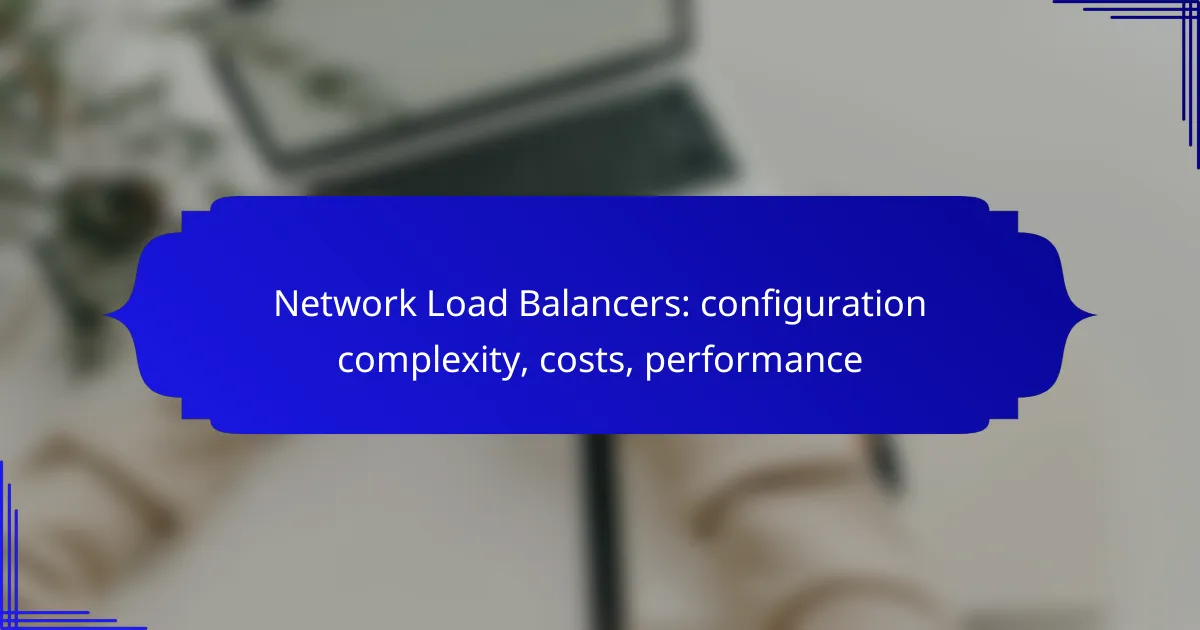Network load balancers play a crucial role in managing traffic and ensuring optimal performance for applications. In New Zealand, options like AWS Elastic Load Balancing and F5 BIG-IP offer varying levels of configuration complexity, costs, and performance capabilities. Understanding your specific needs and traffic patterns is essential for effective configuration, which can lead to enhanced performance and cost savings.

What are the best network load balancers for New Zealand?
The best network load balancers for New Zealand include AWS Elastic Load Balancing, F5 BIG-IP, Citrix ADC, NGINX Plus, and HAProxy. These options vary in terms of configuration complexity, costs, and performance, making it essential to evaluate them based on specific needs and use cases.
AWS Elastic Load Balancing
AWS Elastic Load Balancing (ELB) automatically distributes incoming application traffic across multiple targets, such as EC2 instances, containers, and IP addresses. It offers several types, including Application Load Balancer, Network Load Balancer, and Gateway Load Balancer, each tailored for different use cases.
In New Zealand, AWS ELB pricing is based on the number of load balancers and the amount of data processed, making it scalable for varying workloads. Consider starting with the Application Load Balancer for web applications that require advanced routing features.
F5 BIG-IP
F5 BIG-IP is a robust solution that provides advanced traffic management and security features. It supports various protocols and offers extensive customization options, making it suitable for complex enterprise environments.
While F5 BIG-IP can be more expensive than other options, its performance and feature set justify the cost for organizations requiring high availability and security. Evaluate licensing models and consider the total cost of ownership, including hardware and support.
Citrix ADC
Citrix ADC (formerly NetScaler) is known for its performance optimization and application delivery capabilities. It provides load balancing, SSL offloading, and application firewall features, making it a comprehensive solution for web applications.
In New Zealand, Citrix ADC offers flexible deployment options, including on-premises and cloud-based solutions. Its pricing can vary significantly based on the features selected, so assess your specific needs to avoid unnecessary costs.
NGINX Plus
NGINX Plus is a popular choice for organizations looking for a lightweight and efficient load balancer. It combines web server and load balancing functionalities, making it ideal for high-performance applications.
With a subscription model, NGINX Plus offers features like session persistence and health checks. It is generally cost-effective, especially for smaller deployments, but ensure you have the technical expertise to configure it properly for optimal performance.
HAProxy
HAProxy is an open-source load balancer known for its high availability and reliability. It supports both layer 4 and layer 7 load balancing, making it versatile for various application types.
While HAProxy is free to use, consider the potential costs of support and maintenance if you lack in-house expertise. It is a great option for organizations that want a customizable solution without the licensing fees associated with commercial products.

How to configure network load balancers effectively?
To configure network load balancers effectively, focus on understanding your traffic patterns, selecting the right algorithms, and ensuring redundancy. Proper configuration can enhance performance, reduce costs, and improve user experience.
Step-by-step configuration guide
Begin by assessing your application’s traffic characteristics, such as peak usage times and types of requests. Choose a load balancing algorithm that fits your needs, such as round-robin for even distribution or least connections for resource-heavy applications.
Next, set up health checks to monitor the status of your servers. This ensures that traffic is only directed to healthy instances, improving reliability. Configure SSL termination if necessary to offload encryption tasks from your servers.
Finally, implement redundancy by deploying multiple load balancers in different availability zones. This setup enhances fault tolerance and ensures continuous service availability.
Common configuration pitfalls
One common pitfall is neglecting to configure health checks properly, which can lead to routing traffic to unresponsive servers. Always ensure that your health checks are correctly set up to avoid downtime.
Another issue is overloading a single load balancer without considering scaling options. Monitor performance metrics and be prepared to add more instances or adjust configurations as traffic increases.
Lastly, failing to document your configuration changes can lead to confusion during troubleshooting. Maintain clear records of settings and modifications to streamline future adjustments and maintenance.

What are the costs associated with network load balancers in New Zealand?
The costs associated with network load balancers in New Zealand can vary significantly based on the provider, configuration, and usage patterns. Generally, businesses can expect to pay for both the infrastructure and data transfer fees, which can accumulate based on traffic levels and the specific features utilized.
Pricing models of AWS Elastic Load Balancing
AWS Elastic Load Balancing offers several pricing models, primarily based on the type of load balancer used and the amount of data processed. For example, the Application Load Balancer (ALB) charges based on the number of new connections and active connections, while the Network Load Balancer (NLB) typically charges per hour and per GB of data processed.
In New Zealand, costs can range from a few NZD per hour for basic configurations to higher amounts for more complex setups. Businesses should consider their expected traffic patterns and choose the model that aligns with their usage to optimize costs.
Cost comparison of F5 BIG-IP vs Citrix ADC
When comparing F5 BIG-IP and Citrix ADC, both solutions have distinct pricing structures that can impact overall costs. F5 BIG-IP generally involves a higher upfront licensing fee, which can range from several thousand NZD to tens of thousands, depending on the features and capacity required. Ongoing maintenance and support costs can add to this total.
In contrast, Citrix ADC often offers a more flexible pricing model, including subscription options that can be more cost-effective for smaller businesses. However, organizations should evaluate their specific needs, as the total cost of ownership will depend on factors like deployment scale and required features.

How does performance vary among different load balancers?
Performance among different load balancers can vary significantly based on their architecture, configuration, and the specific use case. Factors such as latency, throughput, and resource utilization play crucial roles in determining how effectively a load balancer can distribute traffic and manage workloads.
Performance benchmarks of NGINX Plus
NGINX Plus is known for its high performance, often handling tens of thousands of concurrent connections with low latency. Benchmarks indicate that it can achieve response times in the low milliseconds range, making it suitable for high-traffic applications.
When configuring NGINX Plus, consider using features like connection pooling and caching to further enhance performance. Regularly monitoring metrics such as request per second (RPS) and latency helps in fine-tuning the setup for optimal results.
Latency analysis of AWS Elastic Load Balancing
AWS Elastic Load Balancing (ELB) typically exhibits latency in the single-digit milliseconds range under normal conditions. However, performance can be affected by factors such as the number of active connections and the geographic distribution of resources.
To minimize latency with AWS ELB, utilize features like cross-zone load balancing and ensure that your instances are appropriately sized for the expected traffic. Regularly review the AWS CloudWatch metrics to identify and address any latency issues promptly.

What factors influence the complexity of load balancer configuration?
The complexity of load balancer configuration is influenced by several factors, including integration with existing infrastructure and scalability requirements. Understanding these elements helps streamline the setup process and optimize performance.
Integration with existing infrastructure
Integrating a load balancer with your current infrastructure can significantly impact configuration complexity. Compatibility with existing servers, applications, and network protocols must be assessed to ensure seamless operation. For example, if your infrastructure relies on specific software or hardware, the load balancer must support those technologies to avoid potential conflicts.
Consideration of network topology is also crucial. A load balancer should align with your network’s architecture, whether it’s on-premises, cloud-based, or hybrid. This alignment can simplify the configuration process and reduce the risk of misconfigurations that could lead to downtime.
Scalability requirements
Scalability requirements directly affect how a load balancer is configured. If your application experiences fluctuating traffic, the load balancer must be able to scale up or down efficiently. This may involve configuring auto-scaling features that adjust resources based on real-time demand, which can add layers of complexity to the setup.
When planning for scalability, consider the expected growth of your application. For instance, if you anticipate a significant increase in users, ensure that the load balancer can handle higher loads without compromising performance. Regularly reviewing and adjusting the configuration in response to traffic patterns can help maintain optimal performance levels.

How to choose the right load balancer for your business?
Choosing the right load balancer involves assessing your specific business needs, including traffic volume, application architecture, and budget. The ideal load balancer should enhance performance, ensure reliability, and fit within your financial constraints.
Key selection criteria
When selecting a load balancer, consider factors such as scalability, security features, and ease of management. Scalability ensures that the load balancer can handle increasing traffic without performance degradation. Security features, like SSL termination and DDoS protection, are essential for safeguarding data.
Cost is another critical criterion. Evaluate both the initial setup costs and ongoing operational expenses, which can vary significantly between hardware and software solutions. For instance, cloud-based load balancers often operate on a pay-as-you-go model, which may be more cost-effective for smaller businesses.
Decision matrix for load balancer selection
Creating a decision matrix can simplify the selection process. Start by listing your requirements, such as performance metrics, budget, and specific features. Assign weights to each criterion based on its importance to your business.
Next, evaluate potential load balancers against these criteria. For example, if high availability is crucial, prioritize options that offer redundancy and failover capabilities. This structured approach helps clarify which load balancer aligns best with your operational goals and financial limits.

What are the emerging trends in network load balancing?
Emerging trends in network load balancing focus on enhancing efficiency and adaptability through advanced technologies and architectures. Key developments include the integration of artificial intelligence and a shift towards cloud-native solutions, which are transforming how traffic is managed across networks.
Adoption of AI in load balancing
The adoption of artificial intelligence in load balancing is revolutionizing traffic management by enabling more intelligent decision-making. AI algorithms can analyze traffic patterns in real-time, allowing for dynamic adjustments that optimize resource allocation and improve overall performance.
Organizations implementing AI-driven load balancers can expect reduced latency and enhanced user experience. For example, AI can predict traffic spikes and automatically allocate resources to handle increased loads, minimizing downtime and ensuring service continuity.
Shift towards cloud-native load balancers
The shift towards cloud-native load balancers reflects the growing demand for scalable and flexible network solutions. These load balancers are designed to operate seamlessly within cloud environments, allowing businesses to leverage cloud infrastructure for enhanced performance and reliability.
Cloud-native load balancers often offer features such as automated scaling and integration with microservices architectures. Companies can benefit from lower operational costs and improved agility, as these solutions can quickly adapt to changing traffic conditions without significant manual intervention.
